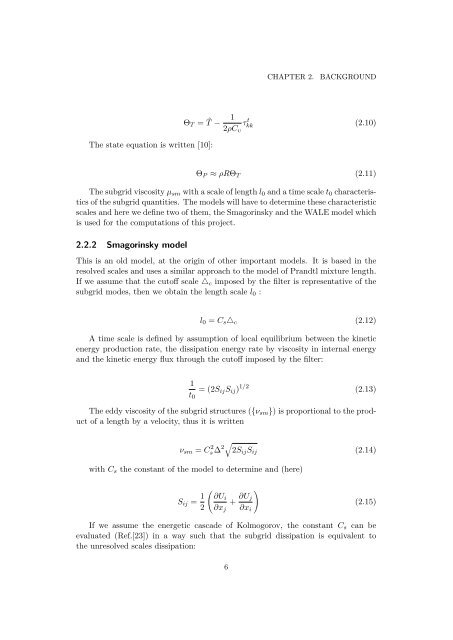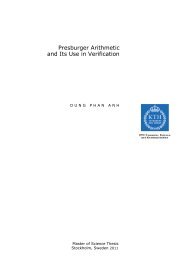Synthetic Inflow Condition for Large Eddy Simulation (Synthetic - KTH
Synthetic Inflow Condition for Large Eddy Simulation (Synthetic - KTH
Synthetic Inflow Condition for Large Eddy Simulation (Synthetic - KTH
You also want an ePaper? Increase the reach of your titles
YUMPU automatically turns print PDFs into web optimized ePapers that Google loves.
ΘT = ˜ T − 1<br />
The state equation is written [10]:<br />
2ρCυ<br />
ΘP ≈ ρRΘT<br />
τ t kk<br />
CHAPTER 2. BACKGROUND<br />
(2.10)<br />
(2.11)<br />
The subgrid viscosity µsm with a scale of length l0 and a time scale t0 characteristics<br />
of the subgrid quantities. The models will have to determine these characteristic<br />
scales and here we define two of them, the Smagorinsky and the WALE model which<br />
is used <strong>for</strong> the computations of this project.<br />
2.2.2 Smagorinsky model<br />
This is an old model, at the origin of other important models. It is based in the<br />
resolved scales and uses a similar approach to the model of Prandtl mixture length.<br />
If we assume that the cutoff scale △c imposed by the filter is representative of the<br />
subgrid modes, then we obtain the length scale l0 :<br />
l0 = Cs△c<br />
(2.12)<br />
A time scale is defined by assumption of local equilibrium between the kinetic<br />
energy production rate, the dissipation energy rate by viscosity in internal energy<br />
and the kinetic energy flux through the cutoff imposed by the filter:<br />
1<br />
t0<br />
= (2SijSij) 1/2<br />
(2.13)<br />
The eddy viscosity of the subgrid structures ({νsm}) is proportional to the product<br />
of a length by a velocity, thus it is written<br />
νsm = C 2 s ∆ 2�<br />
2SijSij<br />
with Cs the constant of the model to determine and (here)<br />
Sij = 1<br />
�<br />
∂Ui<br />
+<br />
2 ∂xj<br />
∂Uj<br />
�<br />
∂xi<br />
(2.14)<br />
(2.15)<br />
If we assume the energetic cascade of Kolmogorov, the constant Cs can be<br />
evaluated (Ref.[23]) in a way such that the subgrid dissipation is equivalent to<br />
the unresolved scales dissipation:<br />
6

















